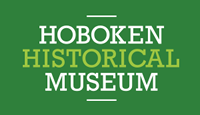The Extraordinary Stevens Family, A New Jersey Legacy: 1776-1911
January 25 – July 5, 2015

Click here to take an interactive virtual tour
“The Extraordinary Stevens Family, A New Jersey Legacy: 1776-1911” detailed the lives and careers of two generations of the family The New York Times referred to as “one of New Jersey’s first families.” The Stevenses were inventors and designers, engineers and urban planners, and their influence is still very much felt, and seen, in Hoboken, and across the nation.
In addition to planning the city of Hoboken, and building many of the town’s major landmarks (Hoboken Land and Improvement Building, Willow Terraces, and Church of the Holy Innocents), and donating land for important institutions such as City Hall and the Hoboken Free Public Library, Colonel John Stevens III, along with his sons Robert Livingston, Edwin Augustus, and John Cox, made major contributions in the areas of steam transportation, railroads, architecture, and education.
Working with archivists and researchers from Stevens Institute of Technology, the first engineering school in the United States that was founded by Edwin Stevens’ estate, the exhibit featured patent models, military uniforms, maps, photos, 19th century furniture and personal family items from the family estate in Hoboken known as Castle Stevens. The museum also displayed original documents from the Stevens Institute of Technology collection, including correspondence with Alexander Hamilton, Aaron Burr, James Madison, Robert Fulton, Richard Stockton, and many other historic figures. Many of these artifacts have never been seen by the public. The Stevens family were very politically astute and their descendants married into some of the most influential families in the country. The family corresponded with presidents and entertained royalty.
The Stevenses were also slaveholders, and the exhibit lecture series will feature a talk about Peter Lee, a former slave who was with the family from 1804 until his death in 1902, when flags were flown at half-mast at Castle Stevens to honor his passing. He was considered a part of the family and is buried in the Stevens family plot. In addition, the time period for this exhibit (mid-1700s through 1900) provides the Museum with a rare opportunity to explore 18th century life in New Jersey.
While the Stevenses’ legacy can be clearly seen and felt in Hoboken, it is their contributions to New Jersey and the nation that will be the focus of this exhibit. Colonel Stevens and his sons were forward-thinking inventors and their innovative designs were adapted by shipbuilders and railway companies across the country. Robert Livingston Stevens, the Colonel’s middle son, revolutionized how trains were built and operated with his invention of the t-rail and spike, still in use today. Father and son were also interested in using steam to power railroads, and in 1826 the Colonel had a track built on his property in Hoboken so he could experiment with a steam locomotive driven by a multi-tubular boiler that carried passengers around the track at 12 miles an hour. This was the first engine and train that ever ran on a railroad in America.
The land that is now Hoboken had been confiscated by the State of New Jersey from a British loyalist and was won in an auction by Colonel John Stevens III, a revolutionary war hero from Perth Amboy, N.J., for $90,000 in 1784. In order to make Hoboken more appealing to homesteaders, Col. Stevens developed Hoboken as a pastoral getaway for New Yorkers weary of the dirty city. Open meadows, walkways along the river, inns, the “natural spring waters” of Sybil’s Cave, were all designed to entice buyers to purchase plots in the newly laid out community. These plots sold slowly at first, even with the added bonus of advertising Hoboken as being free of “yellow fever,” but after Col. Stevens established the Hoboken Ferry Company, with steam-powered ferries making regular trips between Manhattan and Hoboken, the town began to fill with the area’s first commuters.
The Stevens women were equally progressive-minded contributors to the betterment of society. Martha Bayard Dod Stevens, wife of Edwin Augustus and a descendent of the British loyalist who lost the land that Colonel Stevens won at auction, has contributed as much as any of her in-laws. It is probably Martha Stevens whose influence is most felt in Hoboken. Her interests in education, housing for laborers, and opportunities for working women, drove her to establish a foundling hospital, Holy Innocents Church, the Hoboken Free Public Library (National Register of Historic Places), and an industrial training school for young women and men. In addition, as a result of a trip to the Scottish village of New Lanark, a community founded by utopian social reformer Robert Owen, whose clean, affordable housing for workers inspired Mrs. Stevens to commission similar housing at the Willow Terraces in Hoboken. Widowed at age 37, she was left to carry out her husband’s wishes for a school of higher learning to be built on the family property. It was in honor of her family’s innovative natures that she chose to build a school of engineering.
